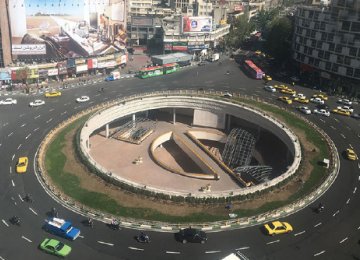The huge plaza in the center of Tehran’s Valiasr Square that was meant to become a space for cultural programs is now nothing more than a godforsaken pit where few passers-by stop to sit and rest after over three months since its launch.
The space in the middle of the high-traffic square in central Tehran was surrounded by fences and tarp for years and what was going on behind was a mystery to the public and the media alike until three months ago.
It had been widely thought that the construction was for an entrance to a Tehran Metro station until a plaza was finally unveiled on March 10.
In fact, the project was initially aimed at building an entrance to Valiasr Square Metro Station, but its purpose gradually changed to include a plaza as well.
In early 2009 it was undertaken by Tehran Urban & Suburban Railway Operation Company (Metro) and was planned to be completed in 2.5 years; however, it took more than three times as long.
There are no traces of cultural programs anywhere in the plaza, which occupies the first floor (street-level) of the seven-story structure.
Naturally, many have become critical of the plaza’s lack of purpose, particularly given that it cost more than 1.6 trillion rials ($42.2 million) to build.
Speaking to ISNA, Rahmatollah Hafezi, head of the Health Commission at Tehran City Council, accused the municipality of initiating projects for the sake of publicity rather than practicality.
“Tehran Municipality only wants to show off,” he said, adding that addressing cultural issues takes a lot more than ostentatious projects.
With Tehran Mayor Mohammad Baqer Qalibaf on his way out of an office he has held for 12 years, Hafezi said the appointment of a new mayor will most likely lead to “creative and practical” solutions to the city’s problems.
Promoting Art, Culture
Maziar Hosseini, traffic deputy at the TM, has spoken in favor of the plaza, arguing that it can serve a variety of purposes.
“It provides a great space to run programs to promote art and culture; the unroofed section can be used to promote street art,” he said.
Hosseini said “fostering the culture of reading” is high on the metro company’s agenda and relevant programs will be launched in the plaza.
The plaza is often compared to the underpass on Valiasr junction (a short distance south of the square); a similar ornate structure that many believe has failed to produce the expected results. It was built with a massive budget but operates only as a place for temporary and weekly markets.
However, Hosseini maintained that whether a project is deemed successful is “subjective”.
Shahram Jabbarizadegan, an urban planning expert, likened the plaza to the crater of a dormant volcano which serves no real function.
“The nostalgic view of Valiasr square has vanished only to be replaced by an underground structure,” he said. “You have to get on a helicopter and fly above the plaza to actually see the inside.”
According to the expert, the building does not even meet the specifications of a plaza as described in urban development documents.
“The building looks more like a pedestrian underpass than a public space,” he criticized. “It looks rather like a crypt and has no attractions.”
Jabbarizadegan stressed that the purpose of an urban structure must be determined before construction begins.
“You can’t devise a function after you build the structure!” he said.
Experts are also critical of the municipality’s not-so-subtle preference for drivers than pedestrians, arguing that TM’s projects are mostly designed to benefit vehicles.
“People are forced to walk underground to reach the plaza, whereas projects such as the two-level Sadr Expressway are designed to keep vehicles on or above street level,” Jabbarizadegan said. “This sends a bad signal to pedestrians.”
Eqbal Shakeri, head of the city council’s Construction Committee, blamed the issue on the involvement of irrelevant entities in the management of cultural spaces.
“The operation of a cultural place must be directed by a specialized department, not by the metro company,” he said. “Just because they’ve built the structure doesn’t mean they must manage it.”






Add new comment
Read our comment policy before posting your viewpoints